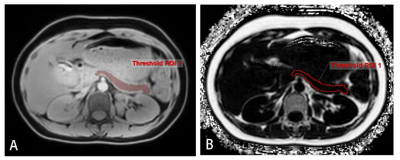2468
The value of 3D mDIXON Quant in quantitative evaluation of factors related to pancreatic volume and fat content in healthy subjects.1Department of Radiology, the First Affiliated Hospital of Dalian Medical University, Dalian, China, 2Philips Healthcare, Beijing, China
Synopsis
Functions of pancreas are associated with its volume and fat fraction. 3D mDixon Quant has been proved to be valuable in measuring fat fraction, which was employed in this study for determination of volume and fat content of pancreas. Then the correlations of pancreas volume and fat content to age, gender and BMI were examined. Results showed a significant negative correlation of age to the pancreas volume, while positive to the fat fraction. Therefore, 3D mDixon Quant is helpful in assessing pancreas volume and fat fraction. As age increases, the pancreas tends to shrink and its fat fraction to increase.
Introduction
Pancreas is an important secretory organ in human body. Shrinking of the pancreas volume and infiltration of fat are observed to be associated with decreased functions of the β-cell, which leads to occurrence of type 2 diabetes1. Related studies have shown that pancreatic fat infiltration can be used as a biomarker to predict the occurrence of type 2 diabetes2. At the same time, pancreatic fat infiltration is also closely related to other metabolic diseases such as obesity3. Therefore, quantitative detections of pancreas volume and fat are of great clinical value. This study was designed to assess the relationships of pancreas volume and fat content to age, gender, and BMI in healthy individuals using the 3D mDIXON Quant sequence.Materials and methods
25 normal subjects (14 males and 11 females) were included in this study, and underwent upper abdomen MRI scans (including 3D mDIXON Quant) at 3.0T. 3D mDIXON Quant sequence scanning parameters:FOV=375×300×168 mm³, TR/TE=6.0/1.05ms, flip angle 3°, voxel size 2.3mm×2.31mm×5.0mm, matrix164×130×67. The pancreatic volume and fat content were quantitatively measured by two observers with diagnostic experiences of 3 years and 5 years, respectively, using double blind method(Figure 1). The data from two observers were analyzed with intra-class correlation coefficients (ICC) to assess inter-observer agreement. The Shapiro-Wilk test was used to evaluate the data normality. The correlations of pancreatic volume and fat fraction to age, gender and BMI were analyzed by Spearman analysis. Multiple linear regression was used to analyze the weight of age, BMI and gender in affecting pancreatic fat scores.Results
There was a favorable agreement between the data from the two observes(Table 1). A negative correlation (r=-0.444) between age and pancreas volume, and a positive correlation (r = 0.739) between age and pancreas fat fraction are observed(P<0.05).Discussion
Advantages of the 3D mDIXON Quant sequence to most of the conventional techniques lie majorly in two aspects. First, with acceleration of compressed-SENSE, 90 layers and 6 echoes can be collected by the 3D mDIXON Quant sequence within one breathhold. Second, precise quantification of fat fraction is achieved with consideration of 7 fat peaks and T2* correction.Conclusion
The 3D mDixon Quant can be a powerful tool for determination of pancreas volume and fat fraction. As the age increases, the pancreas volume tends to shrink and the pancreatic fat fraction to increase.Acknowledgements
No acknowledgement found.References
1Zhao L, Ma J, Wang S, et al. Relationship between β-cell function, metabolic control, and microvascular complications in type 2 diabetes mellitus. Diabetes Technol Ther, 2015,17(1):29-34.
2Lu CQ, Wang YC, Meng XP, et al. Diabetes risk assessment with imaging: a radiomics study of abdominal CT. Eur Radiol,2019,29(5):2233-2242.
3Maggio AB, Mueller P, Wacker J, et al. Increased pancreatic fat fraction is present in obese adolescents with metabolic syndrome. J Pediatr Gastroenterol Nutr,2012,54(6):720-726.
Figures
